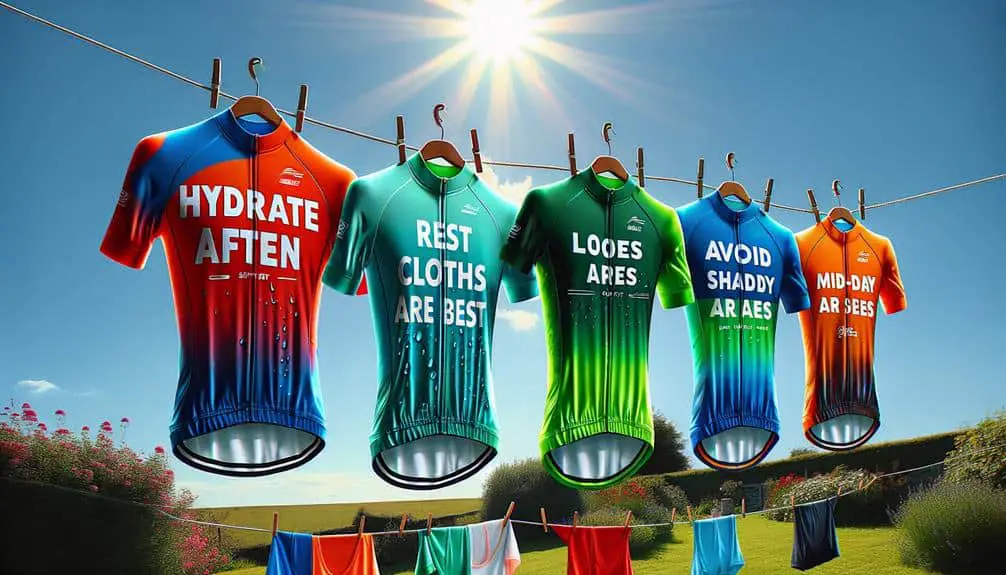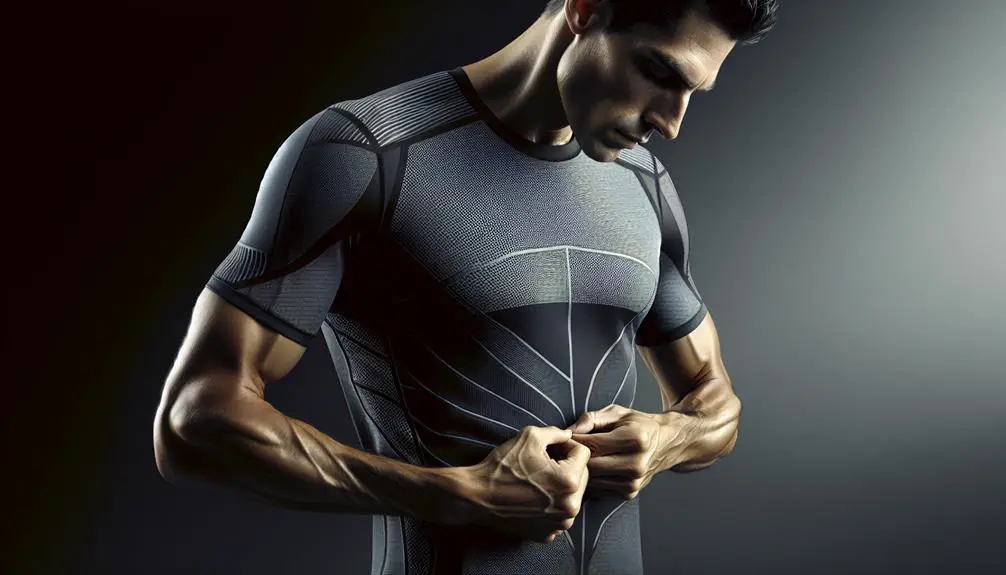Choose moisture-wicking fabrics like polyester, nylon, or merino wool blends. Opt for polyester for excellent moisture control and durability. Nylon offers strength and flexibility for a snug fit. Merino wool naturally wicks moisture and resists odors. Look for fabrics with hydrophobic finishes. Use jerseys with breathable mesh panels for better evaporation and airflow. Pick designs with strategic ventilation openings and full-length zippers for best control. Seamless construction minimizes chafing. Prioritize quick-drying materials, anti-odor properties, and moisture transport systems. Ensure UV protection. Improve your cycling jersey's moisture control with these top 10 tips.
Key Points
- Choose polyester or nylon blends for superior moisture-wicking.
- Opt for jerseys with breathable mesh panels for ventilation.
- Look for quick-drying fabrics to manage moisture effectively.
- Select jerseys with antimicrobial properties to control odors.
- Prioritize UV protection in jerseys for skin safety.
Choose Moisture-Wicking Fabrics Wisely
Selecting moisture-wicking fabrics wisely is essential for peak performance and comfort during cycling. Moisture-wicking benefits are vital as they help regulate body temperature, prevent chafing, and keep you dry even during intense rides.
When choosing fabric technology for cycling jerseys, consider options like polyester, nylon, or merino wool blends. Polyester is widely used for its excellent moisture-wicking properties, durability, and affordability. Nylon is another popular choice due to its strength and stretch, making it ideal for form-fitting jerseys that stay in place during rides. Merino wool blends offer natural moisture-wicking abilities, odor resistance, and temperature regulation, making them suitable for varying weather conditions.
Look for jerseys with advanced fabric treatments like hydrophobic finishes or mesh panels to enhance moisture management further. By selecting the right moisture-wicking fabrics, you can enhance your cycling experience by staying dry, comfortable, and focused on the ride ahead.
Prioritize Breathable Mesh Panels
To optimize moisture control in your cycling jersey, prioritize incorporating breathable mesh panels strategically in high-sweat areas. Essential design is vital for enhancing comfort and performance during intense cycling sessions. Mesh panels allow for increased airflow, which aids in moisture evaporation and temperature regulation. These panels are typically located in areas prone to excessive sweating, such as the underarms, back, and sides of the jersey.
When selecting a cycling jersey with breathable mesh panels, look for advanced cooling technology that complements the design. Manufacturers often integrate specialized fabrics that not only wick moisture away from the skin but also promote rapid drying. This combination of breathable mesh panels and cooling technology creates an efficient moisture management system that helps you stay dry and comfortable throughout your ride.
Investing in a cycling jersey with strategically placed breathable mesh panels and cutting-edge cooling technology can significantly improve your overall riding experience. By prioritizing these features, you can effectively combat sweat buildup and maintain ideal body temperature, allowing you to focus on achieving peak performance.
Opt for Strategic Ventilation Openings
Prioritizing strategic ventilation openings in your cycling jersey design can further enhance airflow and optimize moisture control during your intense rides. Strategic placement of ventilation openings is essential for maximizing ventilation effectiveness. Look for jerseys that feature strategically positioned vents in areas where airflow is most needed, such as the underarms, back, and chest. These openings allow for increased air circulation, helping to regulate your body temperature and wick away sweat more efficiently.
When considering ventilation effectiveness, focus on the design of the openings. Look for jerseys with adjustable vents or mesh panels that can be opened or closed based on your preference and the weather conditions. This adaptability allows you to customize the airflow to suit your comfort level and the intensity of your ride.
Consider Full-Length Zipper Designs
When choosing a cycling jersey, the zipper length can greatly impact the garment's ventilation capabilities. Full-length zipper designs offer maximum control over airflow, enabling you to personalize the level of cooling based on your requirements during the ride.
This characteristic provides practical advantages for handling moisture and ensuring comfort while cycling.
Zipper Length Impact
Consider opting for a full-length zipper design on your cycling jersey for enhanced moisture control during your rides. Full-length zippers provide better ventilation and allow you to regulate your body temperature more efficiently.
Here's how different zipper lengths can impact your cycling experience:
- Improved Temperature Regulation: Full-length zippers offer the most versatility in adjusting airflow and cooling compared to shorter zipper options.
- Ease of Use: Full zippers make it easier to put on and take off your jersey, especially when you need to do so quickly during a ride.
- Enhanced Moisture Wicking: A full-length zipper design helps in quickly wicking away sweat from your body, keeping you dry and comfortable throughout your ride.
Ventilation and Cooling
For ideal ventilation and cooling during your cycling rides, selecting a cycling jersey with a full-length zipper design is essential. The zipper allows you to adjust airflow based on your body temperature and the external conditions.
When choosing a jersey, look for cooling technology integrated into the fabric selection. Opt for materials that wick away moisture and promote quick evaporation to keep you dry and comfortable.
Ventilation placement is key; strategic mesh panels or vents in areas prone to heat buildup, such as the underarms and back, enhance heat management.
Embrace Seamless Construction Methods
When contemplating cycling jerseys, embracing seamless construction methods can greatly enhance your riding experience. Seamless designs reduce the risk of chafing and irritation, providing a more comfortable fit.
Additionally, the benefits of seamless construction extend to improved breathability and moisture-wicking capabilities, enhancing your overall performance on the bike.
Choosing Seamless Designs
To enhance your cycling experience and optimize moisture control, incorporating seamless designs in your cycling jersey is essential. Seamless construction offers a range of benefits, from improved comfort to increased durability. Here are key factors to contemplate when selecting seamless designs:
- Improved Comfort: Seamless jerseys eliminate traditional stitching techniques that can cause chafing and discomfort during long rides.
- Enhanced Moisture Control: Seamless designs often utilize advanced material selection to wick away sweat efficiently, keeping you dry and comfortable.
- Durability: Seamless construction reduces the risk of fraying or tearing, ensuring your jersey lasts longer even through rigorous cycling sessions.
Benefits of Seamless
Seamless construction methods in cycling jerseys offer unparalleled benefits, revolutionizing comfort, moisture control, and durability for avid cyclists.
The seamless design eliminates irritating seams that can cause chafing and discomfort during long rides. By utilizing seamless benefits, cyclists experience a smoother fit that moves with the body, reducing friction and enhancing overall performance.
Concerning fabric selection, seamless construction allows for strategic placement of different materials within the jersey to optimize moisture-wicking properties in key areas. This targeted approach enhances breathability and moisture control, keeping you dry and comfortable throughout your ride.
Additionally, seamless construction enhances the durability of the jersey by reducing potential weak points where seams could come apart over time.
Performance With Seamless
Embrace the benefits of seamless construction methods for cycling jerseys to enhance your performance on the road. Seamless performance is essential for the best moisture management and overall comfort during your rides. Here's why seamless construction can make a difference:
- Reduced Friction: Seamless jerseys eliminate irritating seams that can cause friction and discomfort, allowing you to focus solely on your ride.
- Enhanced Breathability: Seamless designs often incorporate strategic ventilation areas that improve airflow and aid in moisture wicking, keeping you cool and dry.
- Improved Fit: Seamless construction contours to your body shape more precisely, reducing excess fabric and enhancing aerodynamics, which can positively impact your performance.
Make sure to choose a cycling jersey with seamless construction to elevate your riding experience.
Assess Sweat-Resistant Properties
When assessing cycling jerseys for their moisture control capabilities, it's important to carefully evaluate their sweat-resistant properties to ensure peak performance during your rides. Sweat-resistant technology plays a crucial role in managing moisture effectively. Look for jerseys specifically designed with sweat management features, such as moisture-wicking fabrics that draw sweat away from your body to the outer surface for quick evaporation, keeping you dry and comfortable.
Fabric selection is key when it comes to sweat-resistant properties. Opt for materials like polyester blends or merino wool that are recognized for their moisture-wicking capabilities. These fabrics not only help in wicking sweat away but also dry quickly, preventing the buildup of moisture that can lead to discomfort and chafing during long rides.
Evaluate Quick-Drying Capabilities
To assess the cycling jersey's efficiency in managing moisture, examine its quick-drying capabilities through the fabric's composition and design. Quick drying evaluation is important in ensuring your comfort during long rides. Here's how to evaluate this feature:
- Fabric Selection: Opt for synthetic materials like polyester or nylon, which are known for their quick-drying properties compared to cotton. These fabrics wick moisture away from your skin and allow it to evaporate quickly, keeping you dry and cool.
- Construction Design: Look for jerseys with strategic ventilation panels or mesh inserts. These features enhance airflow and aid in the evaporation of sweat, accelerating the drying process. Additionally, seamless designs reduce areas where moisture can accumulate, promoting quicker drying.
- Moisture-Wicking Technology: Choose jerseys with moisture-wicking finishes or treatments. These technologies help in dispersing sweat across a larger surface area, facilitating rapid evaporation and ensuring you stay dry even during intense workouts. Selecting jerseys with these advanced fabric technologies enhances your overall cycling experience.
Look for Anti-Odor Features
After assessing the cycling jersey's quick-drying capabilities, the next step is to focus on identifying anti-odor features that can enhance your overall riding experience. Odor control in cycling jerseys is vital for maintaining freshness during long rides. Look for jerseys that incorporate advanced fabric technology designed to combat odors effectively. Fabrics treated with antimicrobial agents or those with natural odor-resistant properties like merino wool can greatly reduce the formation of odors caused by sweat and bacteria.
When selecting a jersey with anti-odor features, pay attention to the type of fabric used. Synthetic materials like polyester often have moisture-wicking properties that help in odor control by keeping sweat away from the skin and drying quickly. Additionally, some jerseys feature mesh panels strategically placed in high-sweat areas to increase ventilation and aid in odor management.
Investing in a cycling jersey with strong odor control mechanisms not only keeps you feeling fresh throughout your ride but also prolongs the lifespan of the garment by reducing the need for frequent washings. Prioritize anti-odor features to ensure a more comfortable and enjoyable cycling experience.
Emphasize Moisture Transport Systems
Highlighting the significance of moisture transport systems in cycling jerseys enhances your overall comfort and performance during rides. Moisture management is essential for regulating body temperature and preventing discomfort. Advanced fabric technology plays a vital role in achieving efficient moisture control. Here are three fundamental aspects to ponder:
- Wicking Properties: Seek jerseys with moisture-wicking capabilities that draw sweat away from your skin to the outer surface of the fabric, where it can evaporate quickly. Fabrics like polyester blends are renowned for their exceptional wicking properties.
- Breathability: Opt for jerseys designed with breathable materials that allow air circulation, aiding in the evaporation of sweat. Mesh panels and strategic venting improve breathability, keeping you cool and dry during intense rides.
- Quick-Drying: Select jerseys with quick-drying features to make sure moisture doesn't linger on the fabric, which can lead to discomfort and chafing. Fabrics treated with hydrophobic coatings or engineered with quick-dry technology expedite the evaporation process, keeping you comfortable throughout your ride.
Verify UV Protection Factor
Highlight the importance of verifying the UV protection factor when selecting a cycling jersey to safeguard your skin from harmful sun exposure during rides. When choosing a cycling jersey, pay close attention to UV protection features to shield your skin from the sun's damaging rays. Look for jerseys with a UPF (Ultraviolet Protection Factor) rating, which indicates the level of protection the fabric provides against UV radiation. Opt for jerseys with a higher UPF rating for enhanced sun protection.
In addition to moisture control and comfort, ensuring adequate UV protection is essential for maintaining skin health during long rides. Sustainable materials that offer UV protection can provide a durable and eco-friendly solution for cyclists. By selecting a jersey with integrated UV protection features, you can enjoy the ride without compromising your skin's well-being.
Frequently Asked Questions
Can I Machine Wash My Cycling Jersey With Other Types of Clothing?
Yes, you can machine wash your cycling jersey with other types of clothing. Follow these laundry tips: separate colors, use a gentle cycle, and opt for fabric care instructions. This practice guarantees your jersey stays in top-notch condition.
How Often Should I Replace My Cycling Jersey for Optimal Moisture Control?
Swap your cycling jersey for top-notch moisture control by keeping an eye on its wear and tear. A standard jersey lifespan varies from 1-3 years depending on usage. Consistently evaluating fabric quality guarantees timely and effective replacement.
Are There Any Specific Detergents or Fabric Softeners I Should Avoid When Washing My Cycling Jersey?
When washing your cycling jersey, avoid using detergents with heavy fragrances or fabric softeners containing silicone. Opt for mild, sports-specific detergents that preserve fabric performance. Follow safe washing practices like turning the jersey inside out and using cold water to maintain moisture control efficiency.
Can I Use a Fabric Spray or Treatment to Enhance the Moisture-Wicking Properties of My Cycling Jersey?
You can boost your cycling jersey's moisture-wicking prowess with a fabric spray or treatment. Think of it as turbocharging your gear for superior performance. Select products designed for enhancing moisture control to optimize your cycling experience.
How Should I Store My Cycling Jersey to Prevent Moisture Buildup When Not in Use?
To properly store your cycling jersey and prevent moisture buildup when not in use, make sure it is completely dry before hanging in a well-ventilated area. Avoid storing in damp places to prevent odors and maintain the fabric's moisture-wicking properties.


